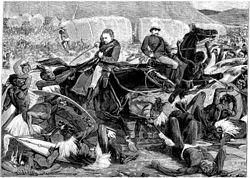伊散德尔瓦纳战役
| 伊散德尔瓦纳战役 | |||||||
|---|---|---|---|---|---|---|---|
| 祖鲁战争的一部分 | |||||||
 泰格茅斯·梅尔维尔 †及内维尔·科吉尔 †两位中尉带着军旗撤退 | |||||||
| |||||||
| 参战方 | |||||||
|
| 祖鲁王国 | ||||||
| 指挥官与领导者 | |||||||
|
安东尼·邓霍中校 † 亨利·普林少校 † |
Vumindaba kaNthati Mavumengwana kaNdlela | ||||||
| 兵力 | |||||||
|
第三纵列 |
祖鲁部队: | ||||||
| 伤亡与损失 | |||||||
|
超过1,300人战死:[3] | 2,000人受伤[10] | ||||||
伊散德尔瓦纳战役(英语:Battle of Isandlwana)发生于1879年1月22日-1月23日,为祖鲁战争先期战争中,极为重要的战役。在英国入侵南部非洲的祖鲁兰十一天后,一支由约20,000名祖鲁战士组成的祖鲁军队袭击了英国主力纵队的一部分,该纵队由约1,800名英国、殖民地和土著军队以及约350名平民组成。[11]祖鲁人主要装备传统的阿塞盖长矛(assegai)铁矛和牛皮盾牌,[12]但也拥有一些毛瑟枪和老式步枪。[13][14]
英国和殖民地军队配备了现代马蒂尼-亨利后膛装填式步枪和两门7磅山炮作为野战炮部署,[15][16]以及海尔火箭炮。祖鲁人在武器技术方面处于巨大劣势,[17] 但他们在数量上远远超过英国人,并最终压倒了英国人,[18]杀死了1,300多名士兵,其中包括所有在前线的士兵。祖鲁军队有1,000至3,000人阵亡。[19][20]
该战役中,20,000名南非祖鲁人成功伏击了英国远征军进攻至伊散德尔瓦纳的约1,700人前锋。尽管面对着军事装备的巨大劣势,但祖鲁人最后仍以约1千至4千人的代价击败英军,并令英军战死超过1,300人,几乎全军覆没。祖鲁人并趁此机会收复罗克渡口的原本失土。
这场战斗对祖鲁人来说是决定性的胜利,并导致英国第一次入侵祖鲁兰的失败。[21]英国陆军在军事技术落后的本土土著敌人面前遭受了最惨重的失败。[17]伊散德尔瓦纳战役导致英国在盎格鲁-祖鲁战争中采取更激进的做法,导致第二次大规模入侵,[22] 并摧毁了开芝瓦约国王透过谈判和平的希望。[23]
注解
[编辑]- ^ All figures from Holme, N. (1999) The Noble 24th: Biographical Records of the 24th Regiment in the Zulu War and the South African Campaigns, 1877–1879 pp. 377–78
- ^ Doyle, p. 120: "... around 20,000 ...". Colenso, p. 313, "The Zulu army, he (Nugwende) says, numbered 20,0000 ..." and p. 312, "... full nominal strength reaches a total of 30,900 men but the actual numbers are estimated at from 20,000 to 25,000
- ^ Knight (2002), p. 86
- ^ 4.0 4.1 4.2 Giliomee, Hermann; Mbenga, Bernard. New History of South Africa First. Tafelberg Publishers. 2007: 166. ISBN 978-0-624-04359-1.
- ^ Smith-Dorrien, Chapter 1D, "... nearly 900 British and 2,000 or 3,000 natives, friend and foe, had breathed their last on the fatal 22nd."
- ^ Lock, p. 224
- ^ Colenso, p. 312, gives 1333 also states a "given" total as 822 but says the actual loss is slightly higher
- ^ Knight, Ian. Isandlwana 1879: The Great Zulu Victory, Osprey, 2002, p. 86, "Zulu casualties were almost as heavy (as the British). Although it is impossible to say with certainty, at least 1,000 were killed outright in the assault...". Knight's estimate of Zulu casualties is more in keeping with those suffered by the Zulu at Kambula, where a British column forms an excellent defensive position with a wagon lager, six 7 pounder artillery pieces and 2,000 soldiers and inflicts 800 (counted bodies) – 1,000 killed on the Zulu. Similarly, Knight & Castle. Zulu War 1879: twilight of a warrior nation, 1992, p. 54 and in their Zulu War, 2004, p. 114, state that the Zulu casualties at Kambula and Isandlwana are comparable. Again, Ian Knight. Brave Men's Blood, The Epic of the Zulu War, 1879, (1990), p. 142, "785 [bodies] were collected from close by the camp", while there is a British pursuit at Kambula that inflicts many casualties on the Zulu, there is only the British retreat at Isandlwana during which the Zulu inflict many casualties. Also Laband, Historical Dictionary, 2009, p. 123.
- ^ Smith-Dorrien, Chapter 1D, "The next few days after the battle, St. Matthew's simile, " Wheresoever the carcase is, there will the eagles be gathered together," was fully illustrated, for literally the sky was darkened at times by continuous streams of " Aasvogels " heading from all directions to the battlefield marked by that precipitous and conspicuous crag, like a lion couchant, " Isandhlwana " where nearly 900 British and 2,000 or 3,000 natives, friend and foe, had breathed their last on the fatal 22nd." As can be seen from this account there were from both sides a total of 2 to 3 thousand natives killed.
- ^ Victor David Davis Hanson, "Carnage and Culture: Landmark Battles in the Rise to Western Power", p. 282, Anchor Books, 2002. Hanson highlights Zulu accounts of how simply being hit by a Martini Henry .45 slug was usually enough for a crippling or maiming wound and in the absence of effective medical care, many wounded Zulus died, within several hours or a few days as result of wounds sustained at Isandlwana.
- ^ Knight (2002), p. 49, Knight gives a total of 1,768 combat troops, not including wagon drivers and other civilians, of which there were some 350, Colenso, p. 263
- ^ Christon I. Archer World History of Warfare, Univ of Nebraska Pr, 2008, ISBN 0-8032-1941-5, p. 462 "They had a national army of twenty-five thousand men equipped with cowhide shields, assegais and clubs."
- ^ Smith-Dorrien, Chapter 1B "It was a marvellous sight, line upon line of men in slightly extended order, one behind the other, firing as they came along, for a few of them had firearms, bearing all before them." eyewitness account, emphasis added
- ^ Ian Knight, Angus McBride Zulu 1816–1906[永久失效链接], Osprey Publishing, 1995, ISBN 1-85532-474-1, p. 25
- ^ Hall, Major D.D. Artillery in the Zulu War – 1879. Military History Journal (The South African Military History Society). January 1979, 4 (4).
- ^ John McAdam, FRGS, "The Role of the Royal Artillery during the Anglo Zulu War". [13 March 2014]. (原始内容存档于13 March 2014).
- ^ 17.0 17.1 Doyle, p. 118: "It was here ... the British Army suffered its worst ever defeat at the hands of a technologically inferior indigenous force." (emphasis added)
- ^ Morris, pp. 366–67
- ^ When Spears Beat Cannons: The Battle of Isandlwana. 29 December 2020.
- ^ Ian Knight Rorke's Drift 1879 Osprey Publishing, 1996, ISBN 1-85532-506-3.
- ^ Thompson, p. 75 "Thus ended the first British invasion of Zululand." Knight (2003), p. 27 Map titled: "First invasion of Zululand".
- ^ Morris, pp. 498–511, Chapter 'The Second Invasion'
- ^ Spiers, p. 42, "... reports of the annihilation ... prompted the Cabinet to send reinforcements and galvanized interest in the war." Ian Knight, Zulu War, Osprey, 2004, p. 11, "The home government, embarrassed by Isandlwana, sought to restore British honour by despatching more reinforcements ..."
外部链接
[编辑]- Zulu: The True Story By Dr. Saul David
- Isandlwana battlefields
- Personal account of the battle by Horace Smith-Dorrien
- Zulunet description of the battle
- Secrets of the Dead – Day of the Zulu 互联网档案馆的存档,存档日期11 November 2012.
- Travellers Impressions
- The Battle of Isandlwana
- The Battle of Isandlwana 22 January 1879, Ian Knight video [1]
- Forgotten Heroes Zulu & Basuto Wars, Roy Dutton,/ [https://www.roydutton.co.uk/my-books/forgotten-heroes-zulu-basuto-wars/
